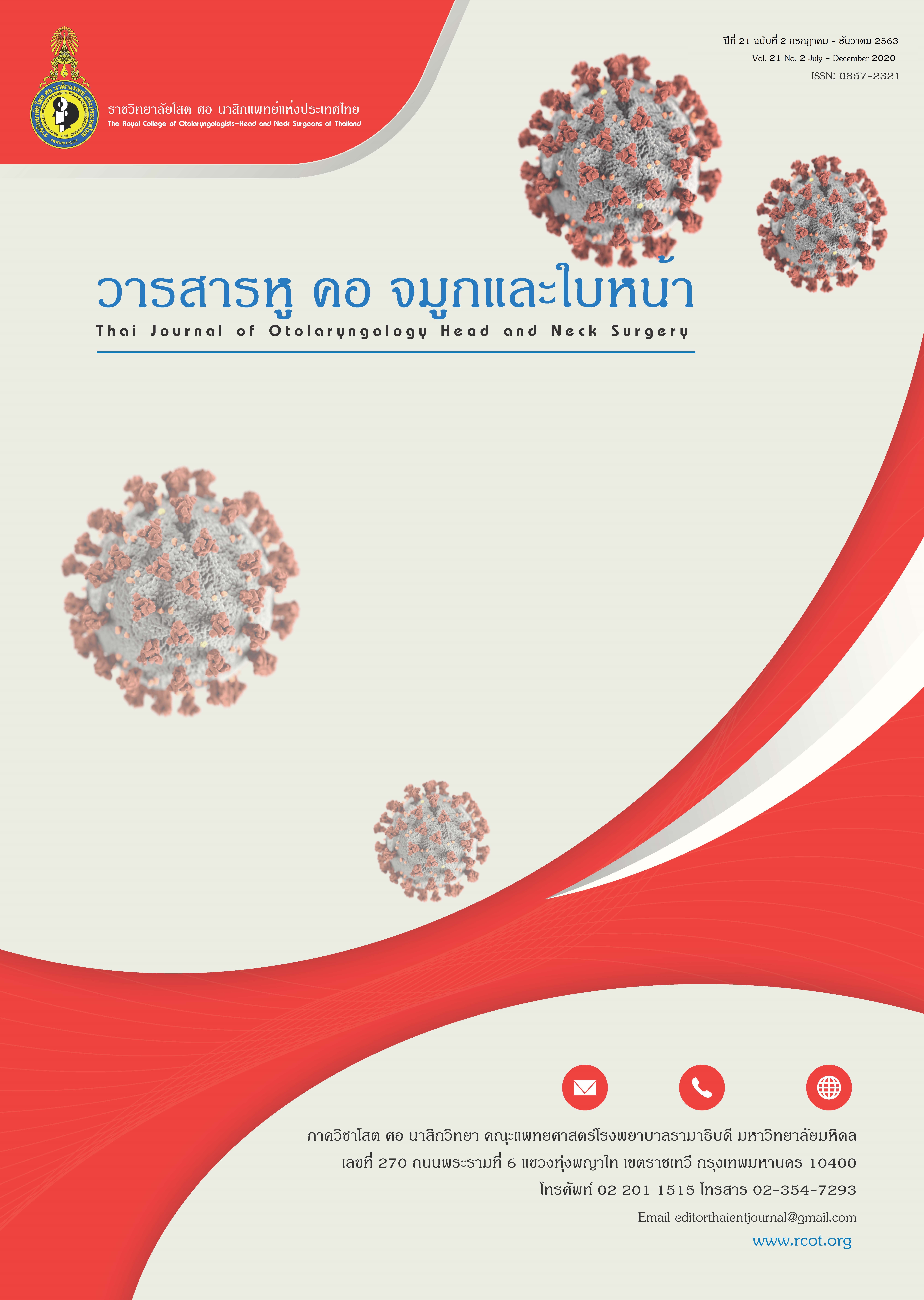Clinical characteristics of loss of smell in COVID-19 Patients in Patong hospital.
Main Article Content
Abstract
OBJECTIVE : To study clinical characteristics of loss of smell, symptoms , treatment and complication in COVID-19 patients in Patong hospital.
STUDY DESIGN : Cross-sectional retrospective descriptive study
SUBJECTS AND METHODS : Review medical records of patients who have been diagnosed with COVID-19 infection, which admitted in Patong Hospital since 1st January 2020 to 30th June 2020.With the exclusion criteria for patients who can’t find information or incomplete medical records.
RESULTS : Seventy-eight patients with confirmed COVID-19 in Patong hospital. The mean age was 34.9 (±9.8) years, and 62 were women (79.5%). The most common of ENT symptoms were sore throat (46.2%), phlegm (41.0%),Rhinorrhea (38.5%), Nasal congestion (23.1%), and total of 19.2% of COVID-19 infected patients had reported loss of smell.Three patients (20.0%) reported isolated sudden-onset anosmia. A total of 80% of COVID-19 infected patients had reported loss of smell and taste.The COVID-19 patients with loss of smell ,93.3% had mild and moderate severity of COVID-19. Loss of smell began 2 days after infection onset. Six patients (60%) reported a totally loss of smell. The mean duration of loss of smell was 7 days Complete recovery was achieved for 80% of the patients within 14 days of symptom onset.
CONCLUSIONS : During the epidemic period of COVID-19 infection, when presenting patients with loss of smell, physicians should consider COVID-19 infection as a differential diagnosis to achieve early identification, avoid the delayed diagnosis, and prevention of transmission.
Article Details
ต้นฉบับที่ส่งมาพิจารณายังวารสารหู คอ จมูก และใบหน้า จะต้องไม่อยู่ในการพิจารณาของวารสารอื่น ในขณะเดียวกันต้นฉบับที่จะส่งมาจะผ่านการอ่านโดยผู้ทรงคุณวุฒิ หากมีการวิจารณ์หรือแก้ไขจะส่งกลับไปให้ผู้เขียนตรวจสอบแก้ไขอีกครั้ง ต้นฉบับที่ผ่านการพิจารณาให้ลงตีพิมพ์ถือเป็นสมบัติของวารสารหู คอ จมูกและใบหน้า ไม่อาจนำไปลงตีพิมพ์ที่อื่นโดยไม่ได้รับอนุญาต
ตารางแผนภูมิ รูปภาพ หรือข้อความเกิน 100 คำที่คัดลอกมาจากบทความของผู้อื่น จะต้องมีใบยินยอมจากผู้เขียนหรือผู้ทรงลิขสิทธิ์นั้นๆ และใหร้ะบุกำกับไว้ในเนื้อเรื่องด้วย
References
2. Chen N, Zhou M, Dong X, Qu J, Gong F, Han Y, et al. Epidemiological and clinical characteristics of 99 cases of 2019 novel coronavirus pneumonia in Wuhan, China: a descriptive study. Lancet. 2020;395(10223):507-13.
3. Denis F, Galmiche S, Dinh A, Fontanet A, Scherpereel A, Benezit F, et al. Epidemiological Observations on the Association Between Anosmia and COVID-19 Infection: Analysis of Data From a Self-Assessment Web Application. J Med Internet Res. 2020;22(6):e19855.
4. European Rhinologic Society. Loss of smell [Internet] ; c2020 [Cited 2020 Apr 17].
Available from: https://www.europeanrhinologicsociety.org/?page_id=2143
5. Farah Yusuf Mohamud M, Garad Mohamed Y, Mohamed Ali A, Ali Adam B. Loss of Taste and Smell are Common Clinical Characteristics of Patients with COVID-19 in Somalia:
A Retrospective Double Centre Study. Infect Drug Resist. 2020;13:2631-5.
6. Giacomelli A, Pezzati L, Conti F, Bernacchia D, Siano M, Oreni L, et al. Self-reported Olfactory and Taste Disorders in Patients With Severe Acute Respiratory Coronavirus 2 Infection: A Cross-sectional Study. Clin Infect Dis. 2020;71(15):889-90.
7. Hopkins C, Kumar N. Loss of sense of smell as marker of COVID-19 infection. ENT UK.
2020;26(03):2020.
8. Izquierdo-Domínguez A, Rojas-Lechuga MJ, Chiesa-Estomba C, Calvo-Henríquez C, Ninchritz-Becerra E, Soriano-Reixach M, et al. Smell and Taste Dysfunction in COVID-19 Is Associated With Younger Age in Ambulatory Settings: A Multicenter Cross-Sectional Study.
J Investig Allergol Clin Immunol. 2020;30(5):346-57.
9. Kanjanaumporn J, Aeumjaturapat S, Snidvongs K, Seresirikachorn K, Chusakul S. Smell and taste dysfunction in patients with SARS-CoV-2 infection: A review of epidemiology, pathogenesis, prognosis, and treatment options.Asian Pac.J Allergy Immunol.2020;38(2):69-77.
10. Klopfenstein T, Kadiane-Oussou NJ, Toko L, Royer PY, Lepiller Q, Gendrin V, et al. Features of anosmia in COVID-19. Med Mal Infect. 2020;50(5):436-9.
11. Lechien JR, Cabaraux P, Chiesa-Estomba CM, Khalife M, Hans S, Calvo-Henriquez C, et al. Objective olfactory evaluation of self-reported loss of smell in a case series of 86 COVID-19 patients. Head Neck. 2020;42(7):1583-90.
12. Lechien JR, Chiesa-Estomba CM, De Siati DR, Horoi M, Le Bon SD, Rodriguez A, et al. Olfactory and gustatory dysfunctions as a clinical presentation of mild-to-moderate forms of the coronavirus disease (COVID-19): a multicenter European study. Eur Arch Otorhinolaryngol. 2020;277(8):2251-61.
13. Lee Y, Min P, Lee S, Kim SW. Prevalence and Duration of Acute Loss of Smell or Taste in COVID-19 Patients. J Korean Med Sci. 2020;35(18):e174.
14. Mishra P, Gowda V, Dixit S, Kaushik M. Prevalence of New Onset Anosmia in COVID-19 Patients: Is The Trend Different Between European and Indian Population? Indian J Otolaryngol Head Neck Surg. 2020:1-4.
15. Özçelik Korkmaz M, Eğilmez OK, Özçelik MA, Güven M. Otolaryngological manifestations of hospitalised patients with confirmed COVID-19 infection. Eur Arch Otorhinolaryngol. 2020.
16. Printza A, Constantinidis J. The role of self-reported smell and taste disorders in suspected COVID 19. Eur Arch Otorhinolaryngol. 2020;277(9):2625-30.
17. Ramasamy K, Saniasiaya J, Abdul Gani N. Olfactory and Gustatory Dysfunctions as a Clinical Manifestation of Coronavirus Disease 2019 in a Malaysian Tertiary Center. Ann Otol Rhinol Laryngol. 2020:3489420963165.
18. Seo MY, Seok H, Hwang SJ, Choi HK, Jeon JH, Sohn JW, et al. Trend of Olfactory and Gustatory Dysfunction in COVID-19 Patients in a Quarantine Facility. J Korean Med Sci. 2020;35(41):e375.
19. Talavera B, García-Azorín D, Martínez-Pías E, Trigo J, Hernández-Pérez I, Valle-Peñacoba G, et al. Anosmia is associated with lower in-hospital mortality in COVID-19. J Neurol Sci. 2020;419:117163.
20. The Centers for Disease Control and Prevention. Symptoms of Coronavirus
[Internet]; c2020 [Cited 2020 Apr 27]. Available from: https://www.cdc.gov/coronavirus/2019-ncov/symptoms-testing/symptoms.html
21. Vaira LA, Salzano G, Deiana G, De Riu G. Anosmia and Ageusia: Common Findings in COVID-19 Patients. Laryngoscope. 2020;130(7):1787.
22. von Bartheld CS, Hagen MM, Butowt R. Prevalence of Chemosensory Dysfunction in COVID-19 Patients: A Systematic Review and Meta-analysis Reveals Significant Ethnic Differences. ACS Chem Neurosci. 2020;11(19):2944-61.
23. Wu J, Liu J, Zhao X, Liu C, Wang W, Wang D, et al. Clinical Characteristics of Imported Cases of Coronavirus Disease 2019 (COVID-19) in Jiangsu Province: A Multicenter Descriptive Study. Clin Infect Dis. 2020;71(15):706-12.
24. ปารยะ อาศนะเสน.ผู้ป่วยที่สูญเสียการรับกลิ่น(ไม่ได้กลิ่น หรือ Anosmia)หรือได้กลิ่นน้อยลง(Hyposmia)
โปรดฟังทางนี้.Available from: https://www.si.mahidol.ac.th/Th/healthdetail.asp?aid=1231


